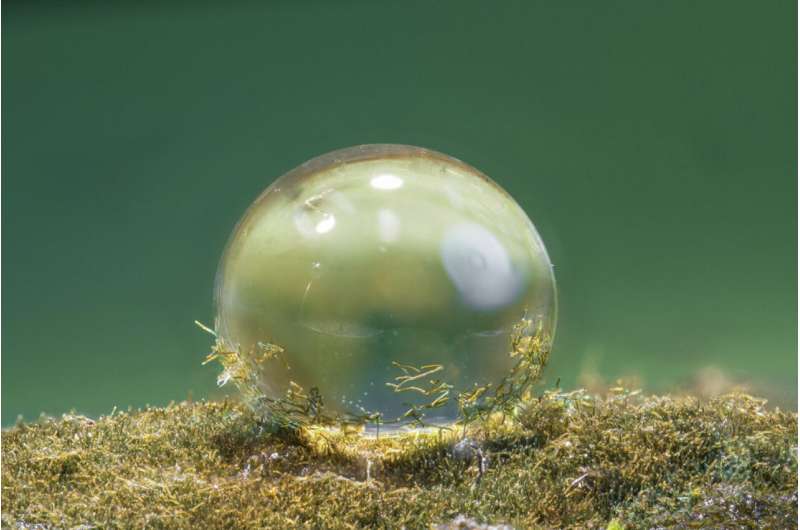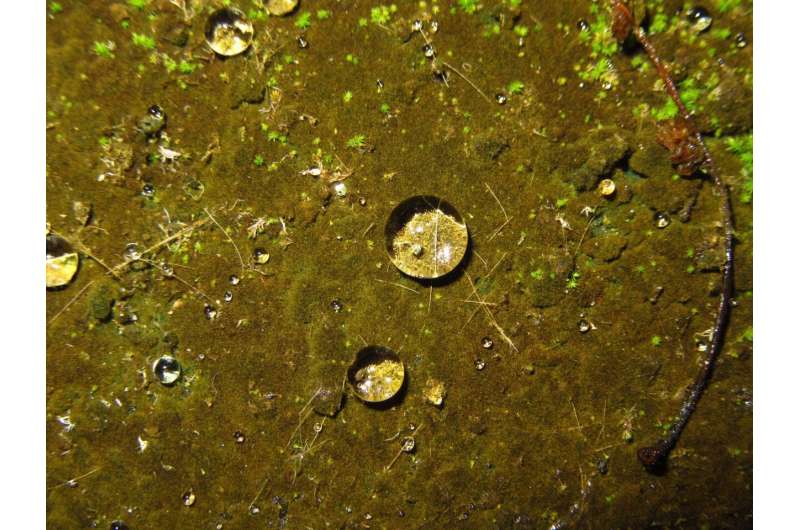Water repellency as the first step to life on land one billion years ago

Plants use the "lotus effect" to self-clean—water droplets simply roll off and clean the surface to reduce infestation with fungal spores, for example, as Professor Wilhelm Barthlott of the University of Bonn discovered four decades ago. But it's not just plants that use the lotus effect—land living cyanobacteria (Hassallia byssoidea) also use extreme water repellency to protect themselves from water films and competitors.
Plants and other organisms have evolved structures and mechanisms for colonizing land for nearly half a billion years. In this context, their surfaces, the crucial physical interface with the environment, mainly act as barriers against water loss. Bonn researchers suggest that extreme water repellency (superhydrophobicity) and associated self-cleaning (lotus effect) was an additional key to algae's transition from water to land about 400 million years ago. "Superhydrophobicity enhances gas exchange on land and excludes aquatic competitors in water films," the research team writes in the journal Frontiers in Plant Science.
In materials science and surface technology, superhydrophobicity has also become one of the most important bioinspired innovations, making it possible to avoid water films and pollution—for example, in facade paints and varnishes. In the paper, the researchers describe an extremely water-repellent biofilm of the desiccation-tolerant cyanobacterium Hassallia byssoidea and provide evidence that the origin of superhydrophobicity is much older than previously thought. It could date back to about one to two billion years ago.

The multicellular bacterium forms "algae-like" filaments that are extremely water-repellent and prevent water films. Short cell filaments remain attached to the unrolling water droplets, causing the organism to spread via a type of droplet infection known as "splash dispersal." Flooded, the bacterial lawn becomes wettable after about a day and continues to grow underwater—and dried out again, it reaches its water-repellency for life on land.
"Now we have robust data for cyanobacteria in terrestrial biofilms that can switch from a hydrophilic to a stable superhydrophobic state—and we assume that superhydrophobicity played a crucial evolutionary role in the transition of almost all organisms on land," says Prof. Barthlott. It is no coincidence that cyanobacteria play a role in the oldest known fossils, the stromatolites. They are composed of thin layers of bacterial mats, probably primarily cyanobacteria, which are generally thought to be the first land dwellers.
The work shows how superhydrophoby evolved from bacteria to green algae, slime molds, mosses and ferns, via the most primitive flowering plant Amborella to lotus leaves. There are a billion years of evolution behind an effect that today has found an everyday industrial application as a superhydrophobicity biomimetic.
More information: Wilhelm Barthlott et al, Superhydrophobic Terrestrial Cyanobacteria and Land Plant Transition, Frontiers in Plant Science (2022). DOI: 10.3389/fpls.2022.880439
Provided by University of Bonn





















